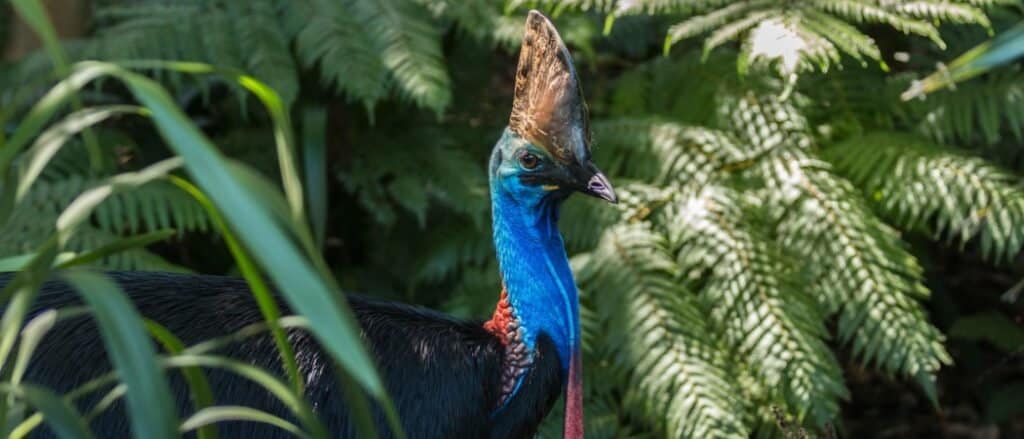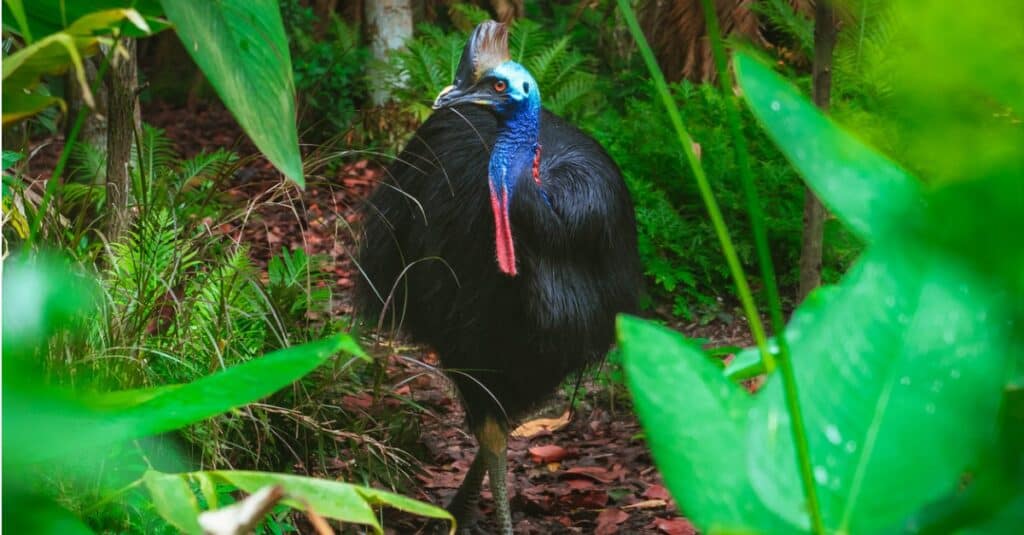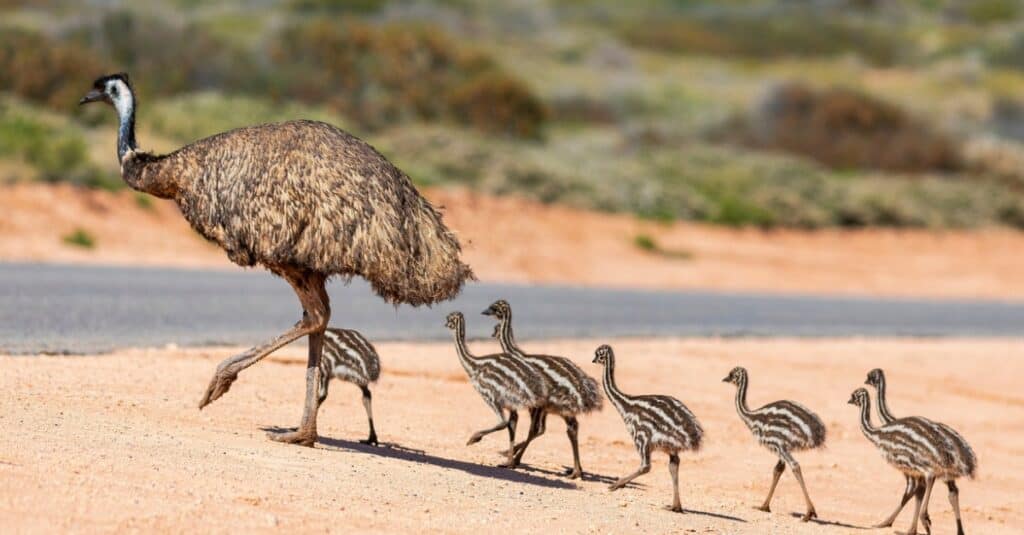The largest birds on earth are also some of the strangest! Besides the ostrich, there are a few other species of bird that run around on two legs, totally flightless. Despite their lack of aerial ability, these animals can run as fast as cars and can deliver a kick that can kill. Today, we are going to be looking at two of these massive birds; the emu and the cassowary. Although they are often confused with one another, these birds are their own distinct species. Let’s compare the emu vs the cassowary and see what makes them unique!
Comparing an Emu and a Cassowary

| Emu | Cassowary | |
|---|---|---|
| Size | Height: 59-75 inches Weight: 69-82 lbs | Height: 60-72 inches Weight: Up to 160 lbs |
| Appearance | Large birds with brown plumage and legs. Black head with short, blunt beak and brown eyes. | Large birds with black plumage, colored necks of blue, red, and orange, with a distinct casque (keratinous head structure). |
| Range | Mainland Australia | Northeastern Australia, New Guinea, and other small islands. |
| Habitat | Arid woodland, savannah | Dense rainforests |
| Pairing | Travel in pairs, occasionally group into large flocks. | Solitary birds. |
| Various species | Single extant species | Three extant species |
The Key Differences Between an Emu and a Cassowary
The key differences between an emu and a cassowary are appearance, range, habitat, and group behavior.
Emus and cassowaries are two of the largest birds that live on earth, with only the ostrich being larger than the both of them. Both birds have a range within Australasia but have distinct habitats and ranges. The emu and the cassowary are closely related and, as a result, share a lot of similar features.
When it comes to size, the emu is generally taller, although the cassowary is almost always heavier. Regardless, a kick from either bird is likely to end you up in the emergency room.
Additionally, emus are muted in color and appearance. They are generally brown and dull, with little color across their bodies. The cassowary is the opposite, with deep black plumage and a neck that is vibrant blue, orange, and red.
Let’s go over some of these differences between the emu vs the cassowary in detail below.
Emu vs Cassowary: Size

Emus are slightly taller than cassowaries.
The emu is the second tallest bird in the world, only behind the ostrich from Africa. Most individuals measure between 59 and 75 inches tall, although they can be taller. When it comes to weight, the emu is the third heaviest bird species, behind the ostrich and the cassowary. Most emus weigh between 69 and 82 lbs.
The cassowary is the third tallest bird, behind the ostrich and the emu. Most cassowaries measure between 60 and 72 inches tall. Although the emu has a slight height advantage, the cassowary is quite a bit heavier. These dense birds often weigh up to 160 lbs, with some growing larger.
Emu vs Cassowary: Appearance

Cassowaries are black with blue necks and a large fin on their heads.
©iStock.com/picassos
The emu is similar in appearance to the familiar ostrich. Where the ostrich has pink skin and black and white feathers, however, the emu is brown. The feathers across the entire body of the emu are brown, save for their head which is black.
The cassowary is a distinct bird that looks quite a bit different from the emu. Although they have roughly the same shape, cassowaries have deep black plumage across their bodies. Additionally, the skin on their neck is a vibrant blue and often has orange or red streaks throughout. Their heads have a large casque that resembles a shark fin. This casque is hollow and is believed to offer some protection from falling fruits and nuts since the cassowary is known to spend days protecting a fruiting tree.
Emu vs Cassowary: Range

Emus live in Australia.
©iStock.com/Gilnature
Emus are a somewhat common sight across mainland Australia. They live both inland and around the coast, although their habitat is more often found away from the coast. Historically, emus lived on the islands around Australia but have since gone extinct. There are currently some attempts at bringing them back to their historical range, with Kangaroo Island serving as a current example.
The cassowary is also present in Australia, but only in the wet regions of the northeast. Additionally, cassowaries live in New Guinea and the surrounding islands, including East Nusa Tenggara and the Maluku Islands.
Emu vs Cassowary: Habitat

Cassowaries prefer humid rainforests.
©iStock.com/Henry Soon
Emus are adapted to live in arid environments, of which Australia has plenty. They are most commonly found in arid savannahs, dry forests, and near-deserts. They often travel, sometimes moving massive distances in order to find food and water.
Cassowaries are jungle birds, mostly living in wet and humid rainforests. As fruit eaters, rainforests provide ample food for these birds. Although it’s not as common, they will occasionally venture into scrublands, grasslands, swamps, and savannas.
Emu vs Cassowary: Pairing

Emus often pair up or travel in groups.
©iStock.com/JensenChua
The emu is a semi-social bird that often pairs with a mate. The duo will travel and eat together, often with one looking out while the other forages. When the time calls, emus will also group up into large flocks, although this behavior isn’t common. It’s believed that they do this when large distances need to be traversed.
The cassowary is much more solitary than the emu. Generally, cassowaries don’t interact with one another unless they are mating. They are stealthy birds despite their size and are rarely seen, even by humans trying to locate them. When they hear an approaching individual, they melt away into the jungle.
Emu vs Cassowary: Various species
There is only one extant species of emu, although there used to be more:
- Dromaius novaehollandiae, Emu
- D. n. baudinianus, dwarf emu (extinct)
There are three extant and one extinct species of cassowary:
Cassowary:
- Casuarius casuarius, Southern cassowary
- Casuarius unappendiculatus, Northern cassowary
- Casuarius bennetti, Dwarf cassowary
- Casuarius lydekkeri, Pygmy cassowary (extinct)
The photo featured at the top of this post is © iStock.com/Gilnature
Thank you for reading! Have some feedback for us? Contact the AZ Animals editorial team.






